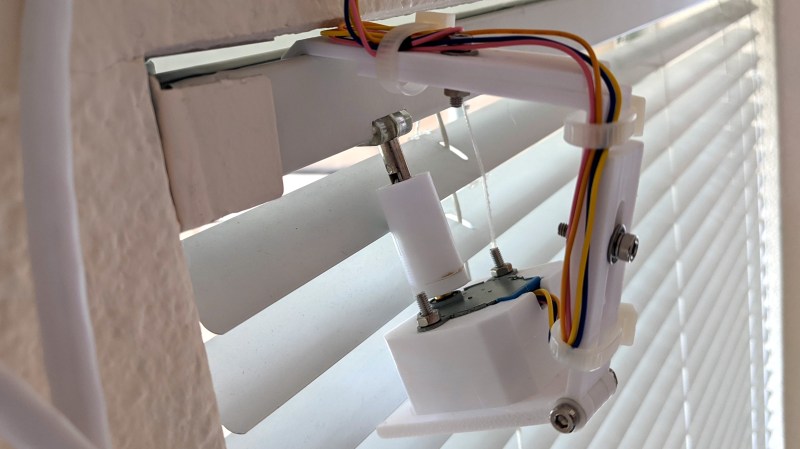[Chris Mullins] wanted to automate opening and closing the slats of mini blinds in his apartment, and came up with a system to do it as a fun project. Manually opening and closing the slats means twisting a rod. Seems straightforward to automate that, but as usual when having to work around something that already exists, making no permanent alterations, complications arose.
The blinds are only 1 inch wide, leaving little room for mounting any sort of hardware. While there is a lot of prior art when it comes to automating blinds, nothing he found actually fit the situation [Chris] had, so he rolled his own.
 The rod that is normally twisted to control the blinds is removed, and the shaft of a stepper motor takes its place. [Chris]’ mounting solution is made to fit blinds with narrow 1 inch tracks (existing projects he found relied on 2 inch tracks) and the 3D printed mount is fully adjustable, so the 28BYJ stepper motor can be moved into exactly the right position. Speaking of the stepper motor, the 28BYJ motor is unipolar but the A4988 driver he wanted to use is for bipolar steppers only. Luckily, cutting a trace on the motor’s PCB is all it takes to turn a unipolar motor into bipolar.
The rod that is normally twisted to control the blinds is removed, and the shaft of a stepper motor takes its place. [Chris]’ mounting solution is made to fit blinds with narrow 1 inch tracks (existing projects he found relied on 2 inch tracks) and the 3D printed mount is fully adjustable, so the 28BYJ stepper motor can be moved into exactly the right position. Speaking of the stepper motor, the 28BYJ motor is unipolar but the A4988 driver he wanted to use is for bipolar steppers only. Luckily, cutting a trace on the motor’s PCB is all it takes to turn a unipolar motor into bipolar.
To drive the motor and provide wireless functionality, the whole thing works with a Wemos D1 ESP8266, an A4988 stepper driver, and a buck converter. While it worked fine as a one-off on a perfboard, [Chris] used the project as an opportunity to learn how to make a PCB using KiCad; the PCB project is here on GitHub and the ESP8266 runs the ESPHome firmware. Be sure to check out the project page on his blog for all the details; [Chris] links to all the resources there, and covers everything from a bill of materials to walking through configuration of ESPHome with integration into the open-source Home Assistant project.
Looking to control natural light but blinds aren’t your thing? Maybe consider automated curtains.















Another thought, could you have lengthened the rod and mounted the stepper on the window sill? Less twisty and the extra weight on the blind bracket is removed
That direct drive linkage looks like an effective way to break something. Oh, well–mini blinds are cheap.
I want a mechanism to open and close the sliding window behind the blinds.
use one of these with H-bridge + ESP8266 if you want automation / DPDT switch for manual:
https://www.ebay.com.au/itm/1500N-Linear-Actuator-12V-Electric-Motor-Max-Load-150KG-W-Brackets-or-Controller/143669694208?hash=item2173618f00:g:~NgAAOSwGKRfI4ur
My simple/cheap design with similar blinds that’s been opening/closing with the sun daily using HomeAssistant for over 4 years (I can’t believe its been that long): https://hackaday.io/project/11891-esp8266-automated-blinds
I never did get to starting the write-up. I pulled the internal shaft out of the rod gearbox and mounted a servo directly to the shaft. I have it set up on 3 sets of blinds and the biggest limitation with expanding to more (excluding getting power to the blinds) is the SG90/MG90S servo only has the torque to reliably turn smaller blinds (>4ft wide or so). I may go back and try an externally mounted solution like this one to take advantage of the rod gearbox for more torque. This printed mount is the cleanest I’ve seen so far for an external design.
https://www.youtube.com/watch?v=ZUu5j29QdLw
Back in college days, we design a solution that would go inside the blinds. I loved the simplicity of using a solar cell to determine the time of day and using that to decide when to open or close the blinds.
https://www.youtube.com/watch?v=DkIQkEemZzw